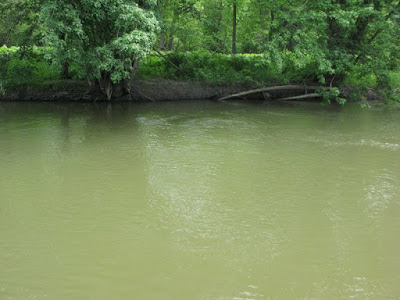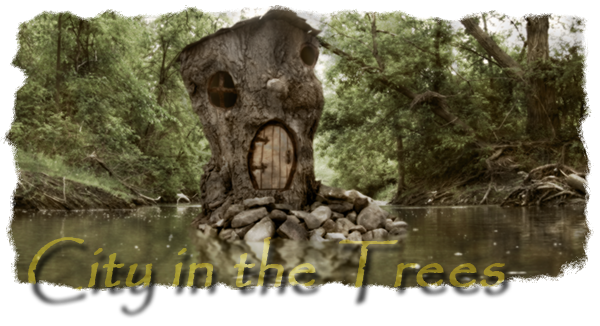Seen from above, the road looks very open. Even with the trees crowding in, there's a definite space between them. And the road was, indeed, unmistakable nearly all the way down. But it wasn't really what I expected.
It was a bit after noon when we arrived. We parked at the end of the maintained road. We probably could have driven further, but first all, we came for the hike, and secondly, I really didn't want to bust an axel or something just to save ten minutes of walking. The road continued on down between two fields, till it came at last to a thick forest. It was overcast, so I wasn't all that concerned about the sun, but given that we were heading into wetlands, we got well set-up with bug repellent as we set out.



The forest trail was blocked off by a steel gate to keep out ATVs (thank you!!), but the way was also strewn with fallen trees every so often that would have made the trip impossible for them... some of them were troublesome even on foot. And they would have had to stay scrupulously on the trail. The nature of the road was unlike any I'd seen before. It was cut through a swamp reminiscent of things I've seen of the Everglades or the bayou in Louisiana. It had obviously been artificially raised above the swamp, with culverts cut into it that the swamp itself had seen fit to supersede with its own methods of transference over time. P-Doug was particularly impressed with what he called the high water marks on the trunks of the trees; they were at eye-height for us, even standing on the road.


As I said, there were a number of places where the swamp had taken it upon itself to balance the water on either side of the road. There were so many fords of water, streaming northeasterly, that I lost count of them. Six, maybe seven, and every one of them different in some aspect. Some were simply one foot in, one foot out; others were fifty feet wide. Some were deep with slippery clay bottoms; others were rafts of plants where I barely got my ankles wet. They were all a challenge, and one I would have delighted in wholly if it were not for the fact that I was carrying two of my cameras with me... and one of them had already been expensively repaired last fall after getting soaked in the Grand River. Otherwise I wouldn't have cared much at all about falling in. But as it was, I was concerned about the cameras, so I put them in the backpack for what little protection that would offer; at least they wouldn't be out, swinging around to potentially put me off-balance.






The road surface changed enormously as we went. It started off as dry gravel, became soft grass, and then in the forest, cool clay and earth. There were places where it was running wet. Mosquitoes were around, but they didn't seem really pronounced until we came to the strangest part of the road of all – completely overgrown with grasses, and ones that grew taller and thicker the further we went. In these places, great swarms of mosquitoes emerged to challenge us for our blood. Most were dissuaded by the bug spray, and those that weren't were often martyred to a quick slap. Even though they largely left us alone, the whining in the ears was highly disconcerting.
The grass on the road was so thick and full that I started wondering if we'd even know the river when we saw it, or would just fall in! Finally I could sunlit trees beyond the gloomy ones, and I knew we'd reached the river. But nature wasn't done with making it tricky yet. We encountered our big nemesis of the past couple of summers there as we approached the water's edge – stinging nettles. These saw-edged, stinging plants that are sheer torture. The slightest contact with them is like having a sharp blade run against your skin, combined with an itch. They really seem to concentrate near the edge of rivers, so for us, the last minute or two of getting to the Nottawasga was an ordeal that the mosquitoes couldn't hold a tiny candle to. They were raking my feet, my shins, my hands when I'd try to brush them aside. And just as we reached the river, we realized we were at the edge of a steep bank... with a very nice broad bank about fifty feet away to our right... through more of the forest. What could we do? We fought on through the nettles and finally reached the bank... where we stood on the clay, panting and cursing and waiting for the pain to subside.
This part of the river was strewn with old fallen trees and logs. There were plenty of places to sit down, so we did. We could finally look around. For all the trouble it took to get to it, it was glorious, and I got to see all the things I really love to see on these hikes. Everything natural. We had the river, places to sit, the bank to wander, the trees all around, and a sky that was first sheltering and then opened up the sun to us when we were ready to receive it.



We decided to try out the river, even though we knew it was too cool yet to really get far. Upper thigh depth seemed to be the prudent place to stop. P-Doug did find a fallen tree that was just exactly positioned to allow him to sit but not get too immersed in the cool water; I reclined on the bank. The bank itself was clay that would support us in some places, but swallow us to the knees in others. I developed a habit of crawling, which seemed to work far better than having to step, sink, haul myself out, and repeat over and over. We covered the place in footprints before we settled back to just enjoy the place.






After a while, we got hungry and wandered back to where we'd left all our stuff and took on the tuna and cracker snack packs he'd brought with him, and the navel oranges. P-Doug had seen evidence of a previous visitor, probably a local fisherman, and he told the sort of tale Tonto might have told the Lone Ranger as he interpreted the missteps, falls, and foibles he read in the clay. After we'd been there an hour and a half or so, we washed in the river, suited up, and prepared ourselves to run the gauntlet of stinging nettles, smothering grasses, tripping hazards, mosquito clouds, and camera-eating fords again. He picked a course that was mercifully sparse of stinging nettles, and off we went.





The trip back seemed considerably shorter to me than the trip down. I think I enjoyed it more. I measured it all out this morning and it was about two-and-a-quarter miles, about half of it the most challenging course I think we've undertaken. But it's exactly what I miss whenever the weather gets cold. So here's to summer.








3 comments:
Now that is some seriously abandoned road. What was it originally used for, do you know?
Jim, hi -- no, we can't imagine. It doesn't serve farmland, and to look at it, it never did. It just charges to the river and ends. There's absolutely no hint of a bridge and there's no sign there was ever a road on the far bank. But someone went to a LOT of trouble to forge a raised road surface there, nearly arrow-straight through a swamp. If I didn't know better I'd be tempted to suggest the Romans must have been trying to province southern Ontario at some point. :)
Hi there, Lone Primate-
I'm enjoying your trip reports, and some of them inspire me to head out and pay these places a visit myself. If you could, a Google Maps link, or lat/long coordinates would be a big help.
Post a Comment